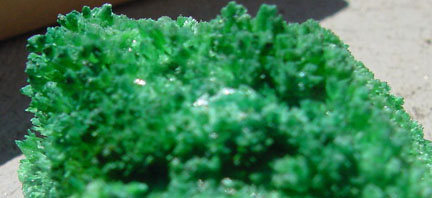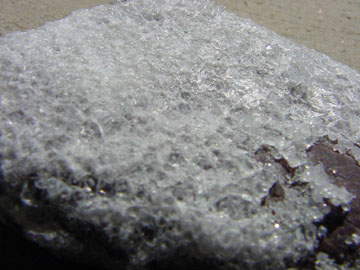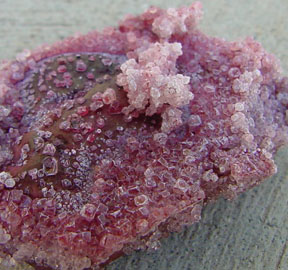Growing Crystals-An Introductory Kit
|
|||
|
Author(s): Jennifer Klipfel & Nabila Jahchan |
Lab Kits - Teacher's Guide |
||
|
Overview: Grow your own collection of sparkling crystals.This lab is not for designed to delve into the chemical details of crystal growth. It is created and marketed to demonstrate the basic idea of crystals and how they are formed. It is a kit for younger elementary and junior high level that emulates the growth of real crystals in nature like diamonds and emeralds. |
|
||
|
|
|
|
|
|
Topics addressed: |
Kit visual |
||
|
|
||
Standards Addressed:Structure of Matter-Eighth Grade Standards
|
|||
|
Procedure: 1- Dissolve the crystal growing chemical in hot water 2- Select a rock, and place it into the growing vessel. 3- Add the solution, and let it cool down to room temperature. 4- After just few hours the first crystals will stat to grow. 5- Keep the vessel in an undisturbed place, so crystals will continue their growth for several days. 6- Crystals can be removed from the solution after about one week.
|
|||
|
Questions: 1- Why hot water should be used to dissolve the salt? In order to grow a crystal, you need to make a solution which maximizes the chances for the solute particles to come together and form a nucleus, which will grow into your crystal. This mean you will want a concentrated solution with as much solute as you can dissolve(saturated solution) and more solute dissolve in hot water than in cold water. 2- Why a rough rock has to be used to grow the crystals on? Sometimes nucleation can occur simply through the interactions between the solute particles in the solution(called unassisted nucleation), but sometimes itŐs better to provide a sort of meeting place for solute particles to aggregate (assisted nucleation). A rough surface tends to be more attractive for nucleation than a smooth surface. 3- How can you keep your treasure crystals? Crystals that were made from a water(aqueous) solution will dissolve somewhat in humid air. Keep your crystal beautiful by storing it in a dry, closed container. You may wish to wrap it in a paper to keep it dry and prevent dust from accumulating on it. 4. How does this simple crystal-formation lab relate to naturally occuring crystal formation we can experience in our world? This first link is to pictures and explanation of Tufa Formations in Mono Lake. These are limestone towers that form underwater and are visible as the water level in Mono Lake falls. This second set of links are of the Tonto Natural Bridge near Payson, Arizona. It is considered to be the largest travertine bridge in the world. A partial part of the story of its formation has to do with precipitation and crystalization out of a solution. http://users.sisna.com/archman/TontoNaturalBridge.html
|
|||
|
Initial set up to grow the crystals |
|||
|
|
"Emerald" crystals, ammonium phosphate "Rose-quartz", ammonium phosphate |
||
|
|
"Aquamarine" crystal, monoammonium phosphate "Diamond" Crystals, potassium aluminum sulfate |
||
|
|
"ruby" crystals potassium aluminum sulfate |
||
|
|
|
||
References & Links: The link below offers some troubleshooting advice for crystal growers and directions for growing different crystals This lab from Carolina Supply is a low-cost simple introductory crystal growing lab. |
|||







